
Roasting a whole pig creates mouth-watering pork crackling as crisp as thin toffee. Roasting pigs in a brick kiln is just one of the food traditions NZ Chinese brought with them from Canton.
Sally Kidson, and visual journalists Virginia Woolf and Braden Fastier explore the story of Chinese food in Aotearoa and the influence it has had on New Zealand’s once bland cuisine.
Made with support from


Alex Tam takes a step towards his custom-built pig oven, widens his stance and lays his strong tanned hands on its hot bricks.
Flames have been heating the two-metre high kiln since 6.30am and Tam, 70, is touching the bricks to determine if the oven is hot enough to receive a whole pig.
There are no thermometers or high tech gadgets in sight.
As a veteran pig roaster Tam instead uses touch, smell, sight, sound and his long experience in his mission to create the perfect roast pig.
Now a dying art, the roasting of a whole pig in a brick oven has been an important part of the food story for New Zealand’s Cantonese Chinese for much of their 180 year history in Aotearoa.
Whole pigs were roasted to feed homesick miners on the Otago goldfields. Ovens were later built on market gardens to fire up for special occasions.

Alex Tam in his greenhouse.
Alex Tam in his greenhouse.
Tam, who talks in heavily accented English, arrived in New Zealand in 1979. He escaped then impoverished China by following an older sister, or “big auntie” as Tam’s son, Colin, calls her, to New Zealand.
The Ōtaki market gardener says roasted pigs - sīu jyū - in Cantonese - are part of the celebratory process for the Chinese community.
He’s cooked hundreds for Chinese New Year parties, one month birthdays - the celebration Chinese hold to mark the first month of a child’s life - weddings and other special events.
Race relations commissioner and second-generation Chinese New Zealander Meng Foon remembers his father roasting pigs - which were eaten at big gatherings.
They would eat them several times a year in Gisborne as parties in the Chinese community were common.
His dad raised pigs and the taste and the crackling was unbelievable, he recalls.

Meng Foon with Jamela Ng and Jane Wing. Foon loves to host friends and family at his Gisborne home.
Meng Foon with Jamela Ng and Jane Wing. Foon loves to host friends and family at his Gisborne home.
“Oh mate. I’m salivating. As a crackling you just bite into it - it’s just so crisp. There’s none of that tension of it not being crispy. It’s just like top top kui, they call it top top kui. More than crispy.”
His other favourite food memory as a child - is not for the squeamish. He remembers catching and helping his parents prepare sparrows.
Like many Chinese meat dishes, Foon said they tasted of “soy sauce and oyster sauce” and ginger and garlic.
Chinese food is renowned for using all parts of the animal and offal and meat dishes with bones in them are also favourites of the affable te reo speaking commissioner.
Foon grew up on a market garden but now lives overlooking Tūranganui-a-Kiwa / Poverty Bay.
He loves to cook and when his family comes home they love to invite wider family members to a get-together.
I think the two Fs you know, food and family - they are everything.
Family gatherings are always noisy, food is eaten loudly, and shared with “15 pairs of chopsticks eating from the bowl”.
“You know it’s quite loud, right? On my first night dining at the Governor General’s home in Wellington I was a bit loud. And so Ying, my wife said, hey that’s very noisy. You know you are not supposed to be slurping your soup.”
Cantonese food has been eaten in New Zealand ever since Chinese miners came to New Zealand seeking their fortune in the 1860s.
The Chinese first arrived in large numbers at the invitation of the Otago Chamber of Commerce to work the dying Otago goldfields.
Even before they arrived the Chinese were seen as a threat. Once on New Zealand soil they experienced racism and discrimination.
In 1857 Nelson set up an anti-Chinese committee. Groups such as the White Race League and Anti-Asiatic League were established in the 1880s.
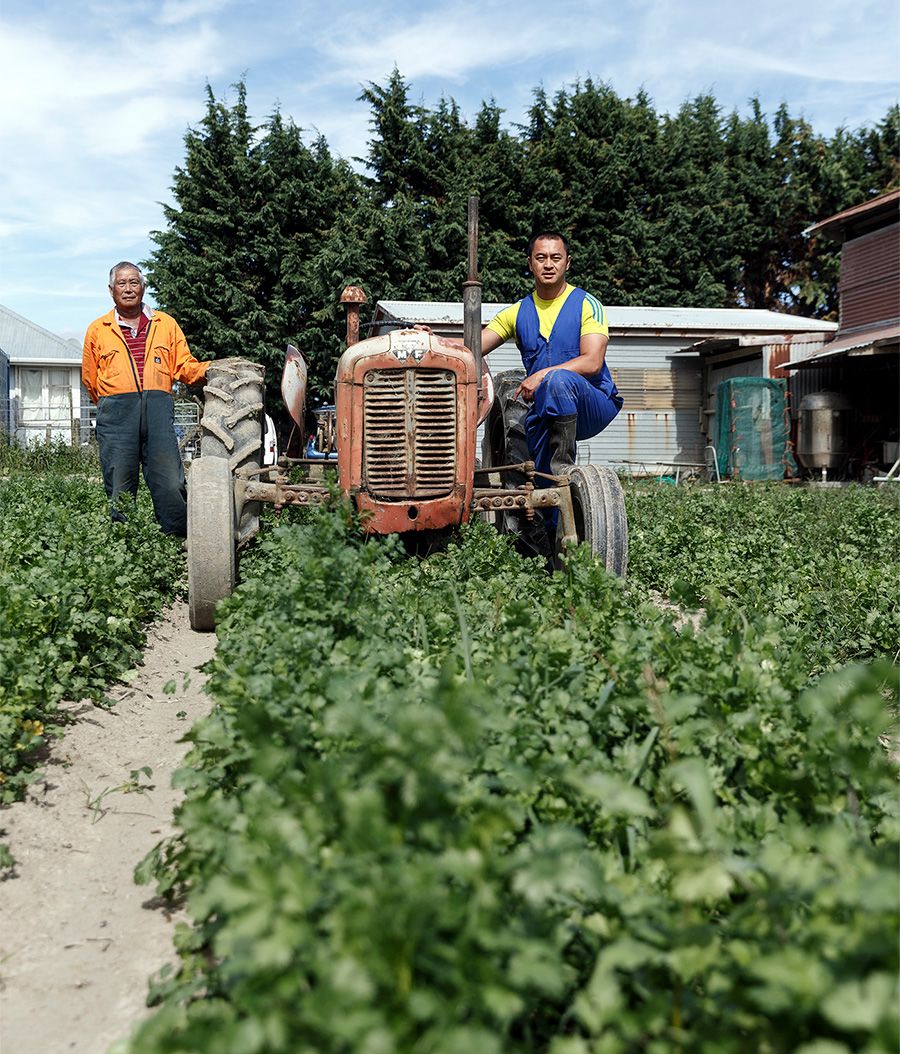
Alex and Colin Tam in the market garden at Ōtaki.
Alex and Colin Tam in the market garden at Ōtaki.
Much like horticultural workers from the Pacific Islands today, the Chinese came to earn money to support families back home.
While they initially did not intend to settle in New Zealand, they were barred from bringing their families and wives with them through the anti-Chinese immigration laws.
The miners hailed from southern China - Guangdong then known as Canton. They lived a frugal life on the harsh Otago goldfields, but Cantonese food was a vital part of New Zealand life.
Lakes District Museum director David Clarke said European miners reportedly suffered from scurvy from living on damper bread, basically flour and water, and mutton.
The Chinese on the other hand ate a wide and varied Cantonese diet, and grew a variety of vegetables.
Tam is anxious.
Like all good cook’s he’s a perfectionist. He wants to produce the perfect pig.
The pig he is working with “KW4 10440”, arrived yesterday. It weighs 64.7kg and has 14mm of fat.
But, Tam is not happy with its size.
“Too big, too big,” he clucks.
The market gardener prefers a smaller factory pig. About 40 to 50kg, and female, is ideal.

A salt rub is done all over the pig before it’s lowered back into the oven for the final roasting.
A salt rub is done all over the pig before it’s lowered back into the oven for the final roasting.
Tam and Colin have already spent two hours preparing the pig. Working deftly, with fingers the size of small cigars they’ve deboned the animal and taken out surplus cuts to ensure the pig cooks evenly. That meat will be cooked separately to become char siu - or barbecue pork.
After 90 minutes the pig lies splayed flat over a stainless steel tray.
A dry rub of salt and Chinese five spice is massaged into the carcass and a marinade sloshed over it, before pig KW4 10440 is put to bed in a chiller in preparation for roasting.
Chef Al Brown has a passion for Chinese food and the role it has played in widening Kiwis’ once bland palettes.
The jovial restauranter talks enthusiastically from his Auckland test kitchen surrounded by an eclectic array of Kiwiana and other oddities. An old fish slice framed on the wall sits opposite a taxidermied cat made into a lampshade.

Ask Brown about Chinese food in New Zealand and he answers in enthusiastic soundbites littered with upbeat adjectives such as magic, sensational and crazy-good.
A world away from his slick Auckland eatery Depot; the be-spectacled chef says his introduction to cheffing was at a place called the Magic Wok in a food hall at the bottom of Wellington’s BNZ Centre.
I made wontons, hundreds and thousands of wontons.
It was the early 80s so he was making food which makes him “cringe to talk about now”.
Dishes such as sweet and sour pork, fried rice, chow mein, noodle dishes and “riffs on that”.
Like many Kiwis, Brown's first introduction to Chinese food came earlier at a Chinese restaurant as a child.
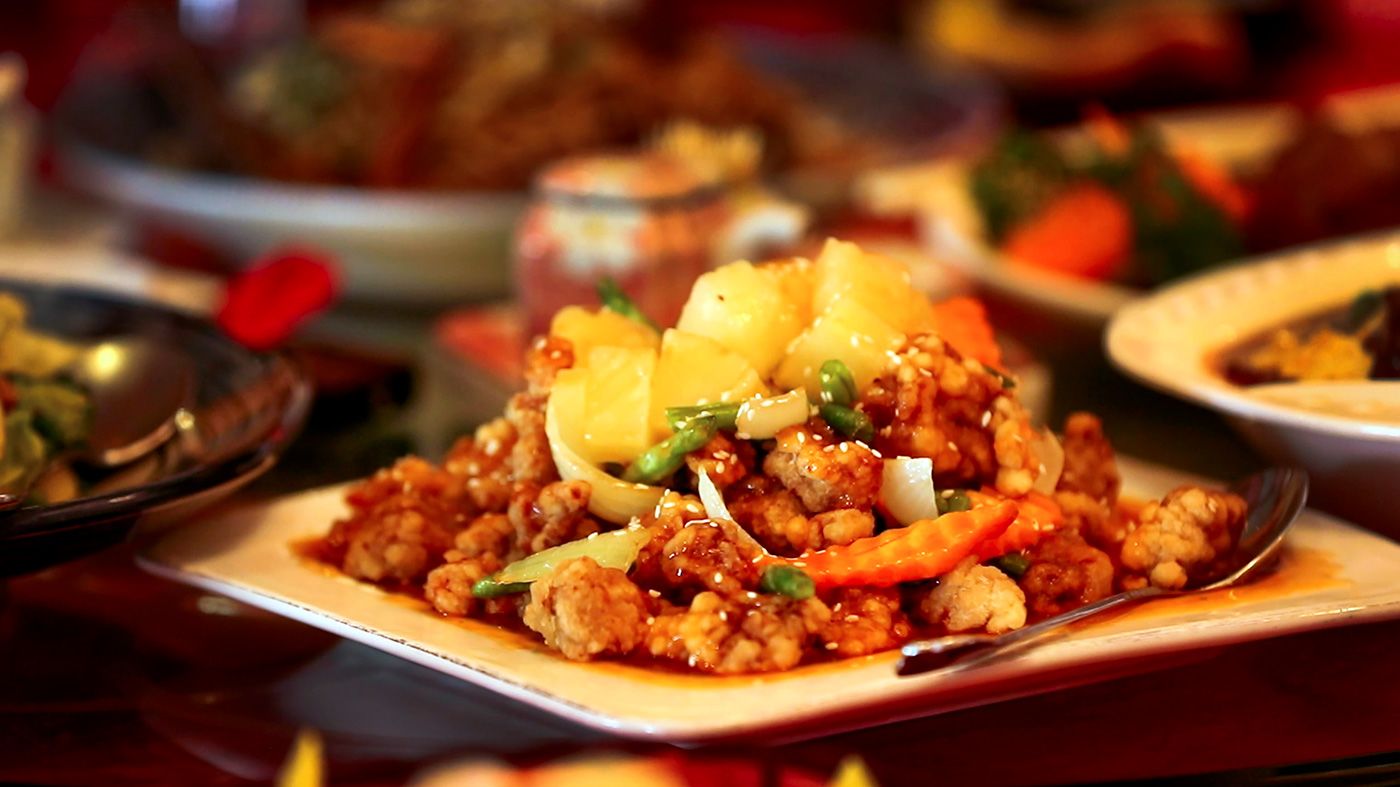
A Sweet and sour dish from New Asia Restaurant Nelson.
A Sweet and sour dish from New Asia Restaurant Nelson.
Sweet and sour pork was the first dish he recalls.
“Shit, I grew up on a farm with potatoes, carrots, cabbage and parsnips with absolutely no seasoning or any spices, you know, so that’s why it was so exotic.”
Each major centre in New Zealand boasted a Chinese restaurant by the 1960s selling Cantonese food. By the 80s restaurants and takeaway shops were spread throughout regional New Zealand.
Kiwis of that era will fondly recall their experience of Chinese food - dishes that were softened for the Kiwi palette.
Fried rice - with red marks around the pork, sweet and sour pork with pineapple, wontons with a pink sauce, shark fin soup, lemon chicken, chow mein, egg foo yong.
Lychees and ice-cream featured for dessert.
“We were fish and chips and pies,” Brown recalls of the Kiwi cuisine at the time.
“That’s how I grew up, but certainly, Chinese cuisine was the first one that would have been regarded as exotic.”
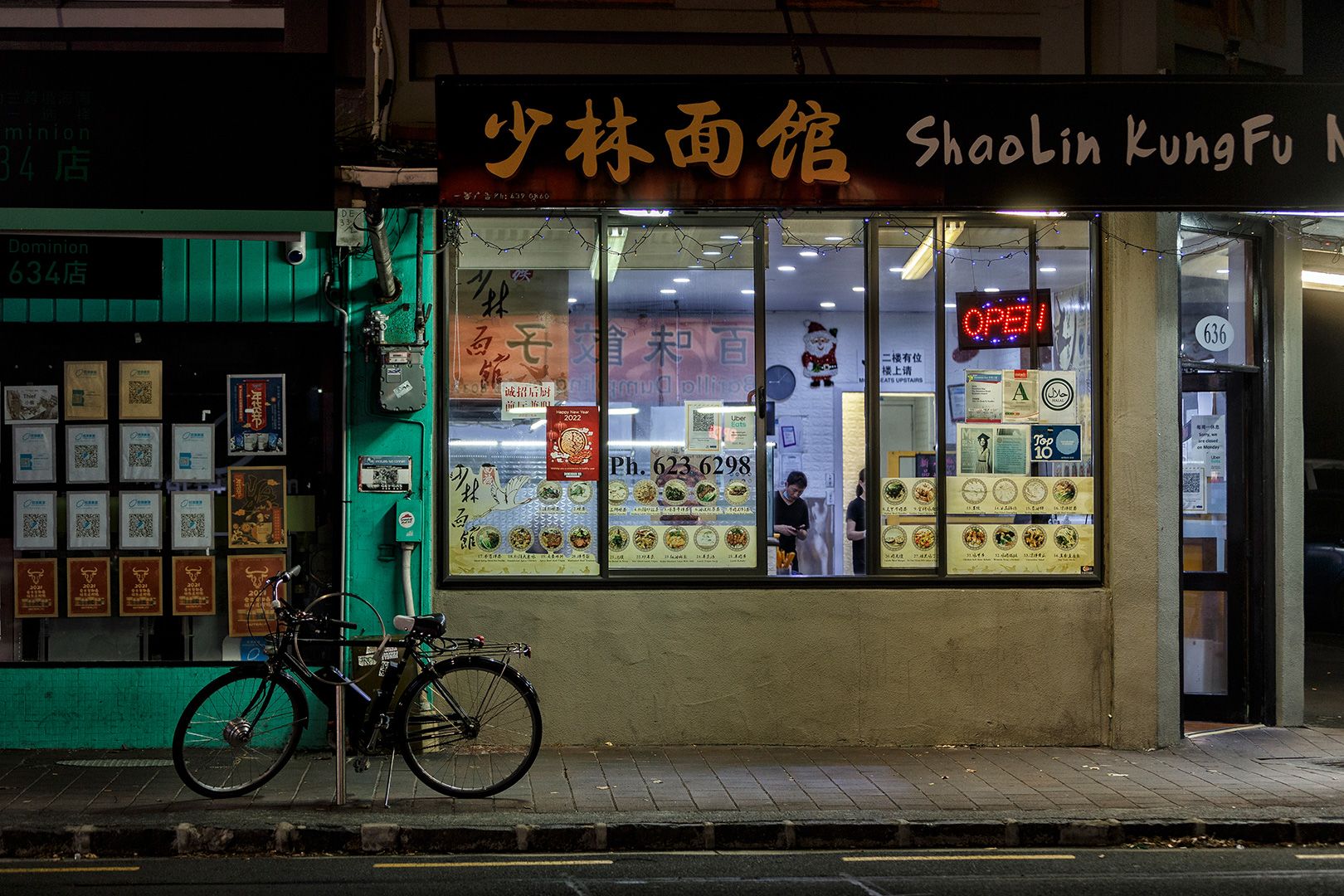
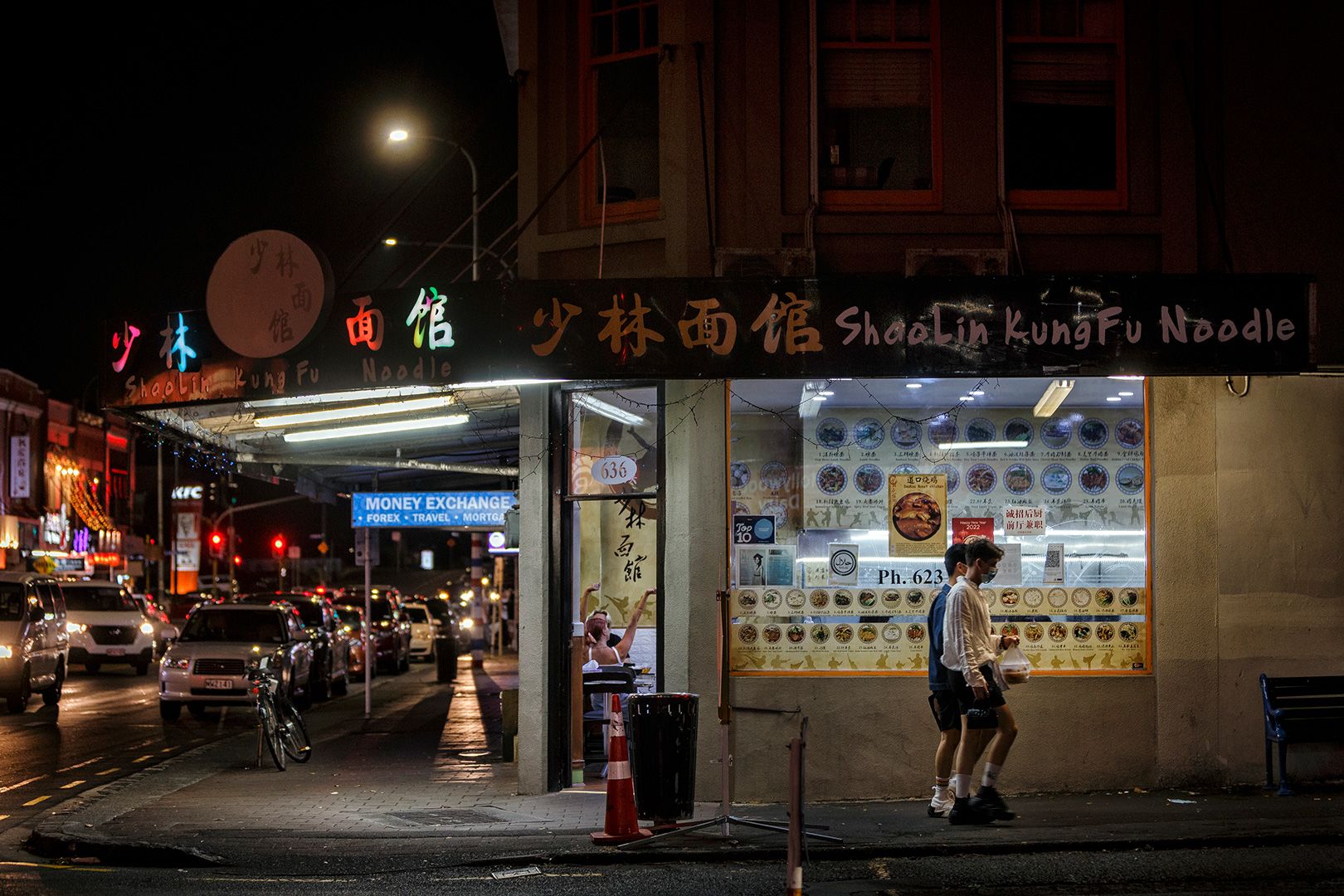
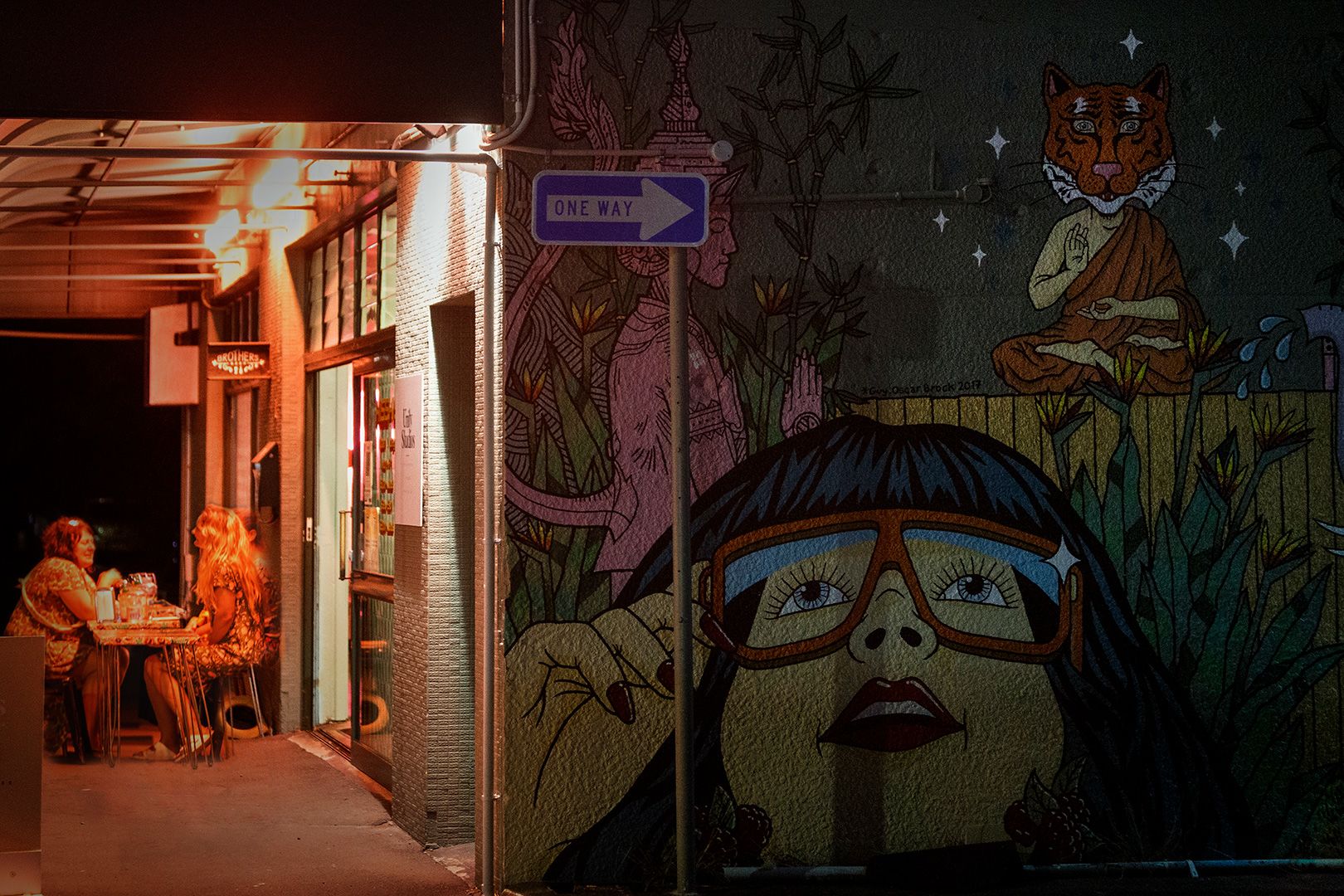
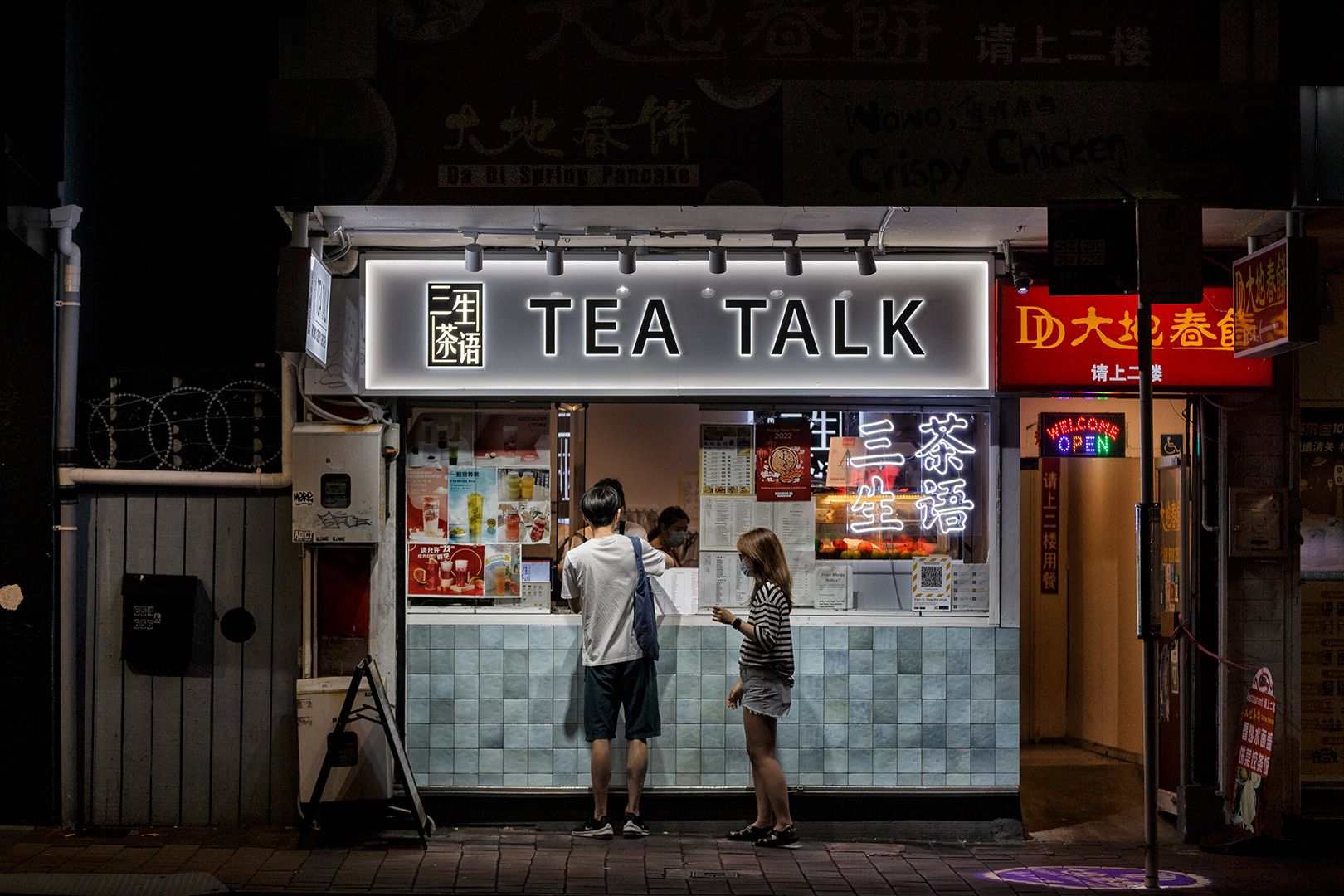




Chinese eateries on Dominion Road.
Chinese eateries on Dominion Road.
Brown’s since travelled and worked in China and has a deeper and more nuanced understanding of Chinese food, and its history, but says the basics he learnt at the Magic Wok have stayed with him.
It’s such a beautiful cuisine in so many ways. A lot of it is about quick cooking and massive heat.
Dominion Road and its proliferation of authentic Chinese eateries is still one of his favourite places to eat “in the world”.
“It’s not about the ambience. It's bright lights, it’s wonky tables, it's kind of dirty menus. But the food: mental, absolutely sensational.”
Brown included the roasting of a whole pig the New Zealand Cantonese way in his cookbook - Stoked. It is, the effusive chef says, one of his top 10 food memories.
“Oh my God, the pig tastes so good … the crackling was incredible, incredible.”
It’s serious work roasting a pig. It’s also competitive.
Variations of pig kilns - including ovens above or below the ground and some partly in and out of the earth were once dotted throughout New Zealand.
Tam says the only other ovens he knows of in the North Island are in Palmerston North and Pukekohe.
Tam, who was a mechanical fabricator in China, has tinkered and modified his oven over the years.
He prefers his above ground oven as he can access the fire at the bottom to regulate the heat.
Pig roasting is a dying art because it is so time intensive. Pig ovens are also decreasing as Chinese market gardens are being sold up.

Alex Tam heads back towards the pig roasting oven after picking a winter melon from his market garden.
Alex Tam heads back towards the pig roasting oven after picking a winter melon from his market garden.
Tam has sold most of his market garden to developers before Christmas.
He has kept his precious pig oven and some land to grow Chinese greens though.
Former Ashburton resident and dietician Carolyn King understands the importance of food to the Cantonese Chinese who have lived in New Zealand for generations.
Both sets of King’s grandparents came to New Zealand between 1908 and 1920. To enter the women had to read 100 words of English and the poll tax had risen to 100 pounds.
The poll tax, or entry tax, is one of the many laws that singled out Chinese - who were seen as alien and a risk to the country’s unofficial white New Zealand policy.
The tax was not abandoned until 1944 and in 2002 then Prime Minister Helen Clark’s government officially apologised to the Chinese for the injustice of the tax.

Roast duck goes under the knife.
Roast duck goes under the knife.
King’s cooking has been influenced by her Cantonese heritage.
She remembers her grandparents killing poultry by chopping its neck with a cleaver and making a dish from the blood.
King says the early Chinese settlers introduced stir-fry cooking to New Zealand by using the fresh produce available.
The main flavourings were garlic, ginger, soy sauces, five spice powder, star anise, dried orange peel, coriander, garlic chives and spring onions.
Food, she says, has been a way to ensure that Chinese culture was continued in New Zealand.
Back at the Ōtaki pig oven - Tam is happy it is the right temperature.
Helped by Colin he lowers pig KW4 10440 into the oven.
After a couple of minutes he hears the skin start to crackle. It sounds like small explosions of fat.
Colin says the first half hour is “the golden time for the crackle”. If it is not popping within 10 minutes then the oven is not hot enough.

The roasted pig is crispy and cooked, and ready to be removed from the oven.
The roasted pig is crispy and cooked, and ready to be removed from the oven.
They pull the pig out after about 30 minutes and it has turned from white-yellow to a pale brown.
Tam relaxes. This pig is going to be a good one after all.
He takes a photo to share on WeChat with his friends in China and Canada, before lowering it back into the oven - which he estimates is at 400 to 500 degrees.

Lucy Xia digs into a bowl of noodles from Shao Lin Kung Fu Noodle House on Dominion Rd, Auckland.
Lucy Xia digs into a bowl of noodles from Shao Lin Kung Fu Noodle House on Dominion Rd, Auckland.
Cantonese food was the main style of Chinese New Zealand food up until the 1990s.
In the mid 1980s New Zealand changed its immigration policy from one that gave preferential treatment to people from Great Britain and Europe to accepting migrants on their merits.
This opened the door for the first time to immigrants from Asia in large numbers.
Asian immigrants experienced racism and a country largely unprepared for their arrival.
However the new migrants - from wider parts of Asia - brought with them new Chinese foods. Post 1990s food trends reflect these new immigration trends with food from outside southern China becoming more well known.
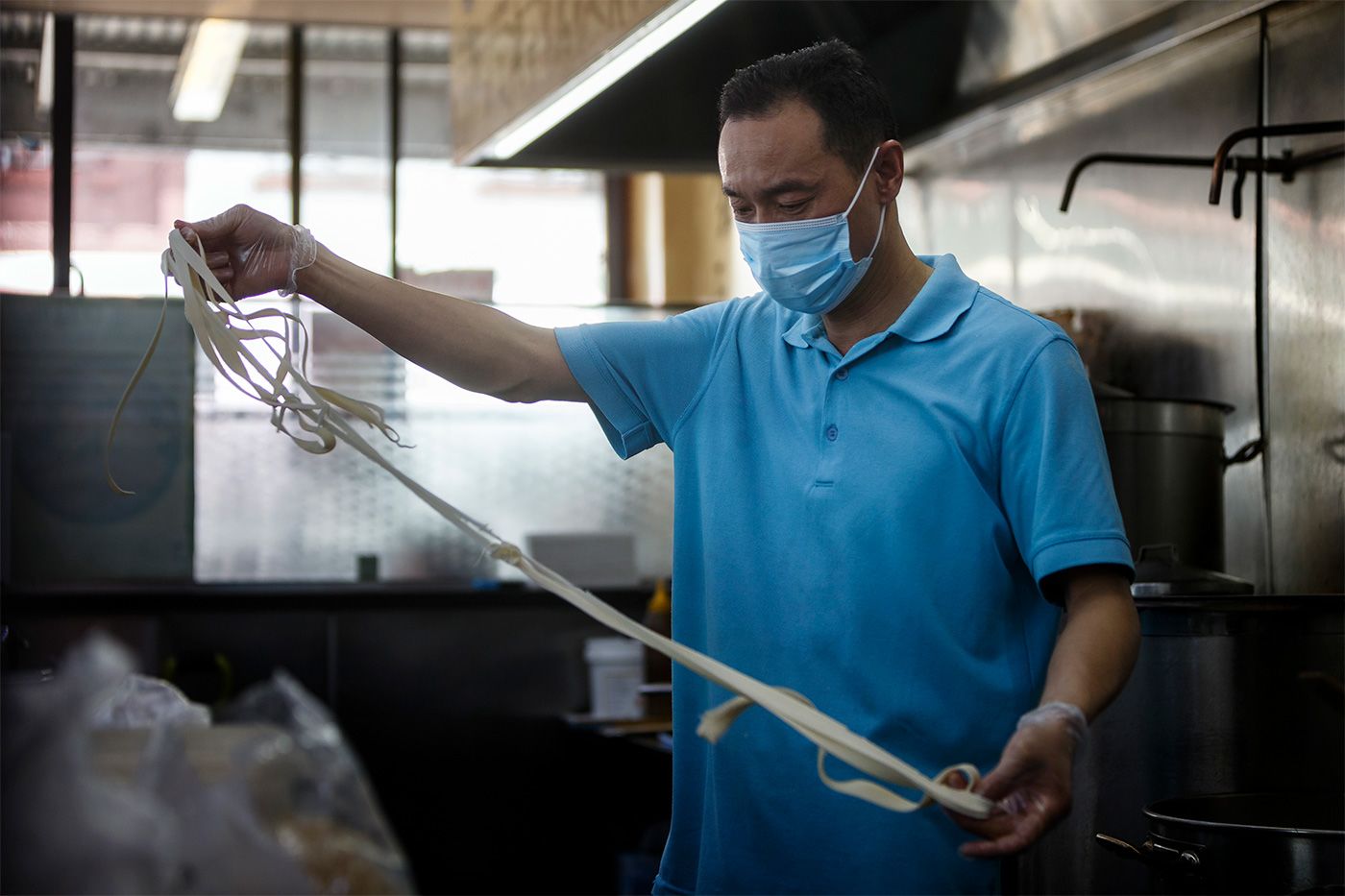
Long noodles mean long life. Fresh noodle making in the kitchen at Shao Lin Kung Fu Noodle House.
Long noodles mean long life. Fresh noodle making in the kitchen at Shao Lin Kung Fu Noodle House.
For example Shanghainese ‘jiaozi’, ‘bao’, hand-pulled noodles and even north eastern Chinese food.
Back in Ōtaki a gold old-style alarm clock with a red minute hand hung near the oven shows it's time to pull out the pig.
Colin and Tam proudly hang the carcass, its skin now a golden wavy brown, in front of the oven.
Back in his shed Tam attacks the pig confidently with a cleaver.
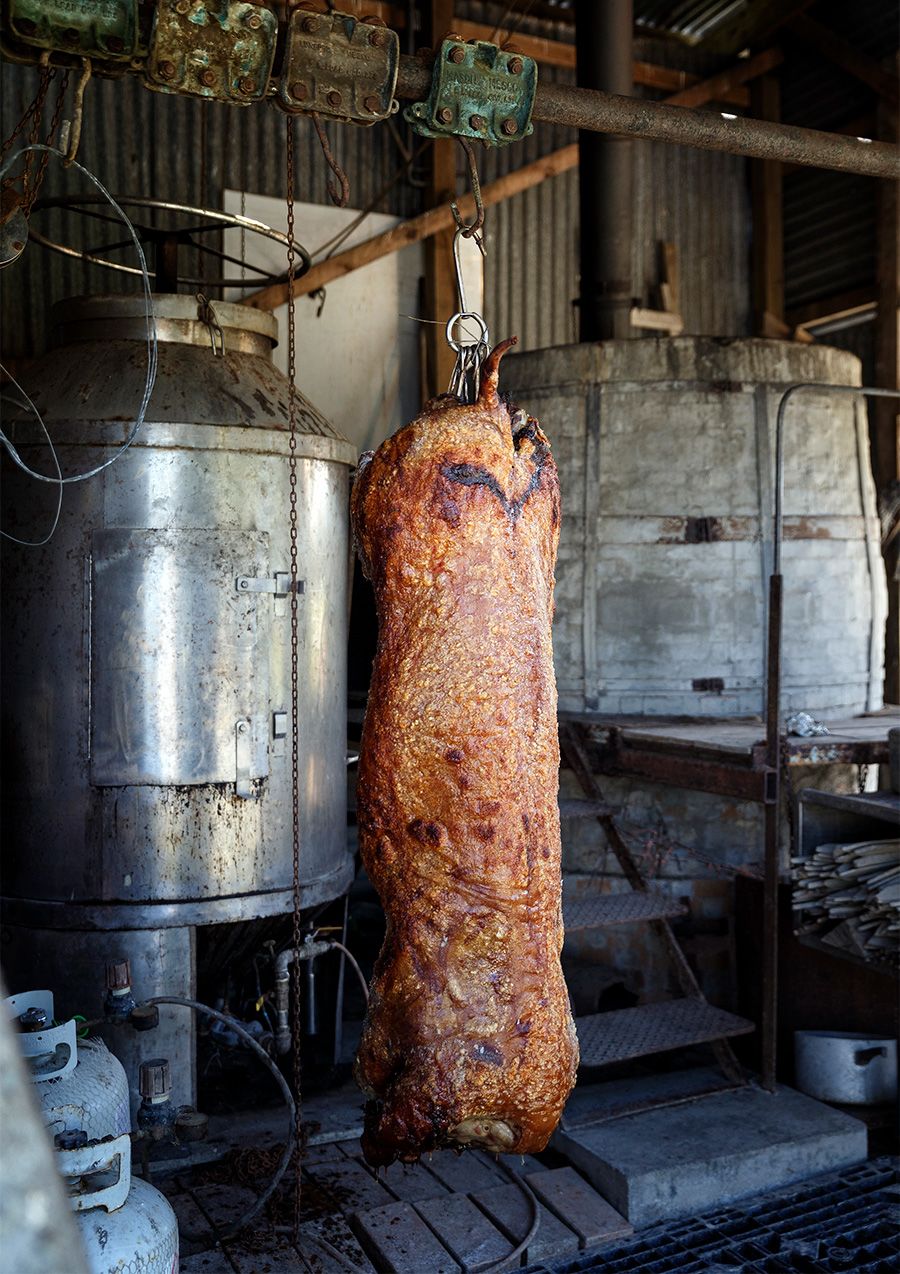
The finished roasted pig ready for carving.
The finished roasted pig ready for carving.
The skin has pulled away from the carcass and its juices are running clear. You can hear the sound of crackle as he cuts into it and small bits of pork and juice fly.
Those gathered have spent the past two days dreaming of the crackling and it doesn’t disappoint.
If you get offered the chance to experience a Chinese roast pig - “take it” Colin advises.
The crackling just melts in your mouth … The fat oozes down your chin … it’s just heaven.
Projects like this take time and resources. Please become a Stuff supporter and help enable this type of work.
Getting to the truth takes patience and perseverance. Our reporters will spend days combing through documents, weeks cultivating delicate sources, and months – if not years – fighting through the Official Information Act, courts and red tape to deliver their stories.
By supporting Stuff you'll help our journalists keep the pressure on. Make a contribution from as little as $1 today.










